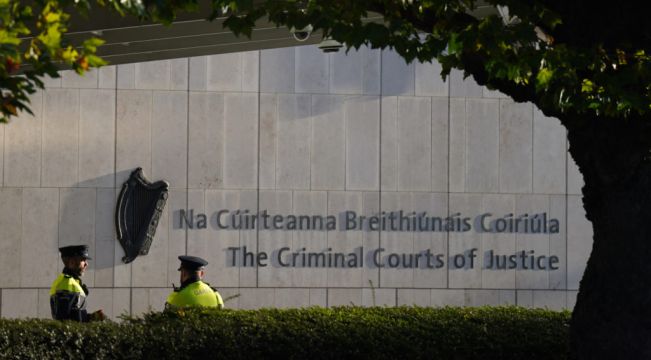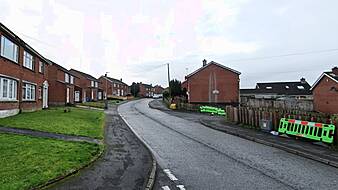A man was "lured" to a country lane just outside Dublin by a trusted friend before being "riddled" with bullets in an execution style killing, a barrister has told the Central Criminal Court.
Lorcan Staines SC opened the case for the prosecution in the trial of Conor Dolan, who denies murdering Neil Fitzgerald seven years ago.
Mr Staines said the prosecution will use circumstantial evidence to prove that Mr Dolan arranged to pick up the deceased from a pub in Tallaght before driving to the remote area where Mr Fitzgerald's body would be discovered the following day.
Conor Dolan (33), with an address at Ashbrook Apartments, Navan Road, Dublin 7, has pleaded not guilty to murdering Neil Fitzgerald (36) at Hills Lane, Crooksling, Tallaght, Dublin 24 on June 5th, 2016.
Mr Staines told the jury of seven men and five women that Mr Fitzgerald's body was found on a quiet country lane where south Dublin quickly turns into countryside as you head south from Tallaght towards Blessington in Co Wicklow.
He was, Mr Staines said, "riddled with bullets" having been shot six times. Counsel suggested that the jury will not have much difficulty concluding that Mr Fitzgerald was executed and that his killing was murder.
The second question, as to whether it was Mr Dolan who committed the murder, will take up more time, he said.
Circumstantial evidence
The case is "in large part" circumstantial, Mr Staines said. It was not caught on CCTV, there is no eyewitness and the murder weapon has never been recovered. The prosecution intends to weave various strands of circumstantial evidence to prove by their cumulative weight that Mr Dolan is guilty, counsel said.
Mr Staines said the deceased was a big man, standing at 192cm (6'3"). He said the jury might wonder how the killer got such a big man to the quiet country lane where he was killed.
He added: "The prosecution case is that he was lured to his death by Conor Dolan and that Conor Dolan was a man he trusted, a man Neil Fitzgerald considered to be his friend."
Mr Staines said the evidence will show that Mr Fitzgerald was shot between five and ten minutes after midnight when a number of witnesses heard gunshots in the area.
CCTV, automatic number plate recognition cameras and mobile phone data will show the movements of the deceased and accused in the hours and minutes before the shooting, he said.
Of particular importance, Mr Staines said, will be four unregistered mobile phone numbers, one of which the prosecution say was operated by Mr Dolan and two of which were operated by the deceased. The fourth "bin phone", he said, was found in a bin having been smashed up.
Despite the damage, gardaí were able to glean information from it and discovered that on the day leading up to the killing it received a text message that consisted only of the 10 digits of the number allegedly belonging to Mr Dolan.
CCTV footage
Mr Staines said a combination of CCTV footage showing Mr Dolan traveling in his distinctive purple BMW 3-series and mobile phone analysis would allow the jury to draw the inference that the person operating the bin phone contacted Mr Dolan and arranged to meet him at a Topaz garage in Dublin's Citywest.
He said the bin phone sent a message stating "I'm in a white van" and Mr Dolan can be seen getting out of his car, approaching a white Transit van and receiving a package from someone in the van.
After that, he said, the bin phone had only one further piece of activity before being dumped.
Mr Staines said the jury will also see CCTV footage of Mr Dolan having his BMW washed at the Topaz garage on the day leading up to the killing.
That is important, he said, because when the same car was examined after the killing, palm marks matching the deceased were found on the boot.
At about 10.30pm that night, Mr Staines said CCTV will show that Mr Dolan picked up Mr Fitzgerald from Madison's Bar in The Square in Tallaght. As they drove south from Tallaght they were stopped by an unmarked garda car at about 10.36pm and two gardai searched their vehicle for six minutes.
The detectives found no firearm, Mr Staines said, and let Mr Dolan and Mr Fitzgerald "go on their way".
About 20 minutes later an automatic number plate recognition camera on the road from Tallaght towards Blessington "pinged" Mr Dolan's registration plate.
Within three minutes of that, the phone attributed to Mr Fitzgerald pinged off a mast beside where his body would be found the next day. Mr Staines said the evidence suggests that Mr Fitzgerald left that area but returned at about midnight.
One minute after midnight, Mr Staines said the accused's phone made five calls in just over four minutes while Mr Fitzgerald's phone sent one text message.
All those activities pinged off a mast "just across from the scene of the death", Mr Staines said and also "coincides with the evidence of bystanders who heard gunshots" between five and ten minutes after midnight.
The following day, Mr Staines said CCTV would show Mr Dolan "returning to the scene of the crime" shortly after 8am. Mr Dolan was arrested at 6.09pm that day and when gardaí searched the house where he had been living, they found a fire burning despite the warm June weather.
In the fire, gardaí found the burnt remains of a rubber glove and a dual sim Nokia phone, he said. Mr Staines said the jury will hear that both Mr Dolan and Mr Fitzgerald were using dual sim phones.
Mr Staines said a circumstantial case boils down to coincidence and the jury's tolerance for coincidence. "How many coincidences can you tolerate before you say, I am satisfied beyond reasonable doubt that I am not dealing with coincidence, or that it would be an affront to common sense to say all these things are just coincidence?"







